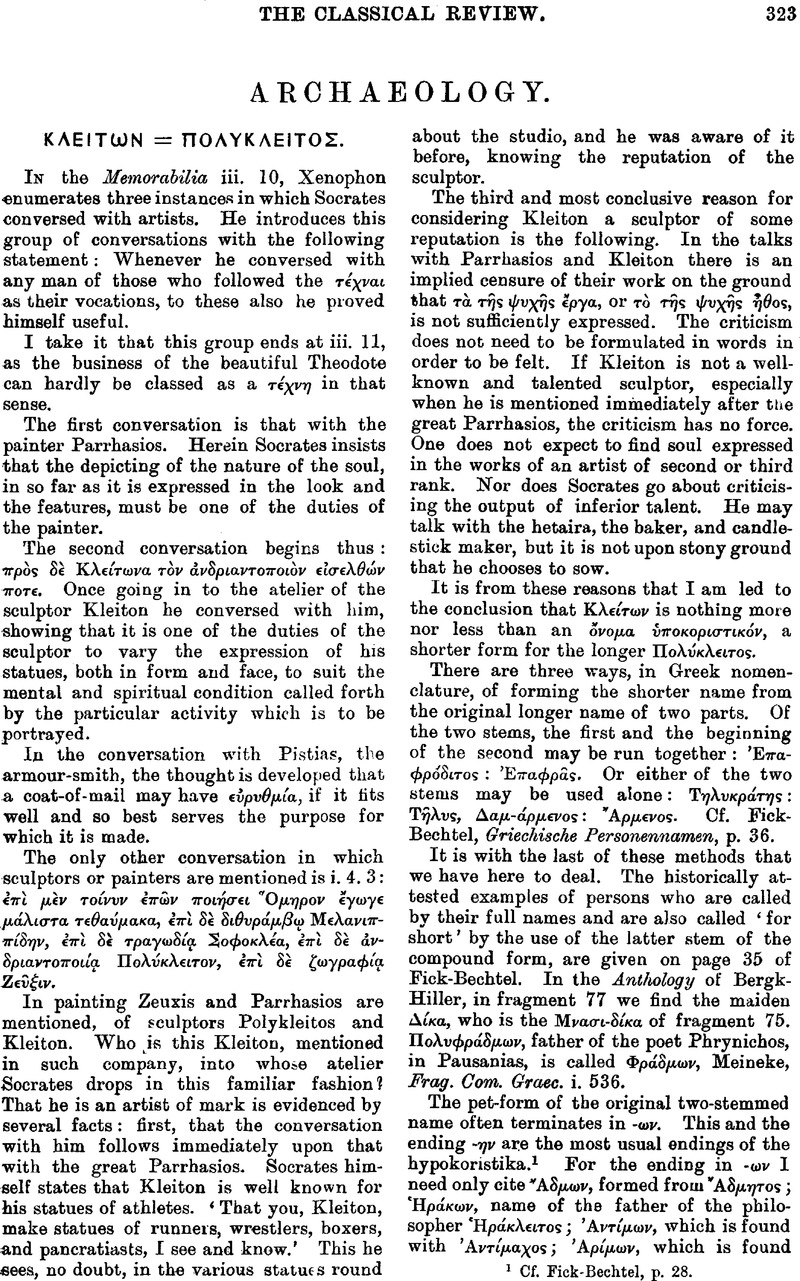No CrossRef data available.
Article contents
Archaeology
Published online by Cambridge University Press: 27 October 2009
Abstract

- Type
- Other
- Information
- Copyright
- Copyright © The Classical Association 1905
References
page 323 note 1 Cf. Fick-Bechtel, p. 28.
page 324 note 1 Memorabilia iii. 10. 1.
page 324 note 2 Acron. upon Horace carm. iv. 8, 6; cf. Seneca, Controv. x. 34, and Pliny, N.H. xxxv. 36, ‘pinxit demon Atheniensium, argumento quoque ingenioso.’
page 325 note 1 Overbeck, , Anlike Schriftquellen, P. 170Google Scholar.
page 326 note 1 Cf. Th. iv. 90. 2 ![]() . Th. v. 18. 2
. Th. v. 18. 2 ![]() . Herod. V. 119
. Herod. V. 119 ![]() .
.
page 328 note 1 Ugonio, Historia delle Stationi di Roma, 120, says ‘Papa Leone X… vi fece una Navicella di marinonova drizzandola sopra unabella base dinanzi alle sue porte. La vecchia si vede quivi appresso mezza rotta, á la to del portico’: but it does not follow that he is right in supposing that there was but one ship and in denying the antiquity of that at present in tront of the church. Nardini speaks of others in the Villa Mattei, according to the authors of the Besehreibung Roms (iii. 1. 491), who saw one still preserved there, though damaged and put on one side: and there is in fact a small one now in the villa, used as a fountain basin.
page 329 note 1 The text is given in Not. Scav. 1904, 365.
page 329 note 2 The identity of the frumentarii and peregrini (the latter being the collective term) is proved by Henzen, Bull. Insl. 1884, 21 sqq.: see Mommsen in Sitzungsberichte der Berl. Akad. 1895, 495 sqq., where he points out that it was into the charge of the princeps peregrinorum that St. Paul's fellow-prisoners were handed over on their arrival in Kome (so Cod. Gigas lot. Stockholm.), he himself being permitted to live in the city under the charge of a soldier—a frumentarius, no doubt (Acts, xxviii. 16).
page 329 note 3 The first of these is published in Not. Scav. 1904, 225, but the conjecture as to its meaning is incorrect.
page 329 note 4 It is impossible to tell which legion is meant—either the xii Fulm(inata) the vii, xxiii, and xiv Gem(ina) or the xxii Prim(igenia)–for the name of the reigning emperor was, from Caracalla's time onwards, taken by all the legions without distinction (Marquardt, , Staatsverw. ii. 455)Google Scholar. The first line should be restored [eormi cul(arius).
page 329 note 5 Close to them, a little further south-east, a tufa sarcophagus with part of its flat covering slab was discovered, which I saw only after it was brought to the surface. It measured 68 cm. high and 62 cm. wide inside, and one end was broken off, so that the length could not be determined, and nothing was found in it.
page 331 note 1 Arch. Anz., 1905, part 1.
page 331 note 2 Notizie degli scavi, 1904, part 5.




